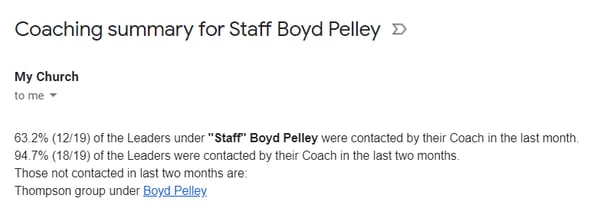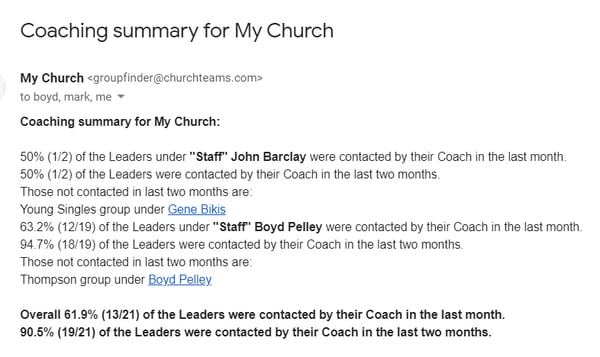 I started this series more than a month ago but got sidestracked on topics related to the Covid 19 crisis. The pandemic has only ramped up. But, for a moment, let's refocus on how we help a church measure how well they are multiplying disciples.
I started this series more than a month ago but got sidestracked on topics related to the Covid 19 crisis. The pandemic has only ramped up. But, for a moment, let's refocus on how we help a church measure how well they are multiplying disciples.
Jesus didn't mentor his disciples just to make them better men. His goal was for them to mentor other people who would do the same thing. Paul was super clear on this multiplication model of mentoring in 2 Timothy 2:2.
We who are captivated by the privilege and challenge of this calling are part of a growing movement of churches owning the multiplication vision. Our experience has shown us that consistency and conversations are two powerfully helpful measures of multiplication.
The difference between adding people to a church and multiplying is captured by the depth of leadership involved. The images of a shepherd with his sheep or a teacher with her students are pastoral and instructive. But, they just involve two generations and focus on the ability for the shepherd or teacher to add people to care for or instruct. Multiplication is different. There are four generations mentioned in this verse:
- Paul
- Timothy
- Reliable People
- Others
You've probably heard the business axiom accredited to W. Edwards Deming, "You can't improve what you can't measure." Well, it's true and here are the ways Churchteams is built to help you measure multiplication so that you can see and improve it.
From The Ground Up
First Generation: These are the members of your serving teams and discipleship groups. Men and women being entrusted with what their team or group leader is passing along. Enrollment is a good measure. Consistency is a better measure because it measures reliability or faithfulness as mentioned in 2 Timothy 2:2.
Question: Which is a better disciple-making ministry one with an enrollment of 500 with 30% consistency or one with an enrollment of 300 with 60% consistency?
Answer: 150 or 180. The ministry with the smaller enrollment is doing a better job of making consistent disciples than the one with the larger enrollment.
Principle: Connection isn't discipleship. It's a pathway to the discipleship environment.
Measure: Enrollment measures quantity. Consistency measures quality (faithfulness). Red members = inconsistent. Yellow = somewhat consistent. Blue = faithful.

Second Generation: These are the leaders of your serving teams and disicpleship groups. They are men and women who are taking what they have learned and passing it along to the 1st generation of people in their group or on their team.
Question: If a count of group or team leaders is a solid way to measure quantity of 2nd generation leaders, is there a way to measure the relative quality of these leaders?
Answer: Same as above. The consistency rate of a group is an indicator of the relational or trust health of the group and thus of the leadership of the group.
Principle: As the leader goes, so goes the group. And vice versa.
Measure: # of leaders measures quantity. Consistency measures quality = group & leader health. Red leaders = danger zone. Yellow = okay. Blue = doing well.

Third Generation: This is the coaching level. As far as I know Churchteams is the only Church management system with a built in four generation coaching structure. Go to Groups & Events > Coach Area to add in coaches who are mentoring those who mentor. Then add their group leaders under them.
Question: In 2006, I asked Carl George, a catalyst of the church growth movement, how he would measure the effectiveness of coaching.
Answer: What percentage of your group leaders have had a mentoring conversation with their coach in the last 30 and 60 days.
Principle: Coaching leaders requires consistent, intentional coaching conversations. Churchteams is known for our reminder system to leaders that allows them to communicate with their group and their upline at the same time every time they meet. But we also provide a reminder system for coaches that shows them their last conversation with their leaders and the ability to schedule ongoing follow-ups.
Measure: % of leaders who've had a coaching conversation n the last 30 days and the last 60 days. Each month the system emails the primary staff person the following coaching summary.

Fourth Generation: In many churches the coach level is made up of staff. There's no problem with that. But as coaches multiply there is a need to track mentoring of these coaches. We call it the staff level. Go to Groups & Events > Staff Area to add in staff who are mentoring those who mentor mentors. Then add their coaches underneath them.
Question: How does the measurement of staff mentoring coaches differ than coaches mentoring leaders?
Answer: Still built around conversations, the staff person is accountable for ensuring coaches are having conversations with their leaders.
Principle: Conversations and time-investment, often known as the "With-Him Principle," are the key to developing multiplying coaches. Of course, foundational to time-investment is a clear strategy or disciple-making template that drives the conversation.
Measure: Fourth generation disciple-makers are accountable for the interactions third generation coaches or mentors are having with their leaders. By using notes taken by coaches on interactions with their leaders, we provide an overall measure of each staff relating to their leaders.
The Staff Area gives Staff the ability to keep notes on their conversations with their coaches, so a Senior Pastor or Elder that wants to interact with a staff person about their ministry, needs to have access to that person's staff area to see their coaching notes. This will provide a fantastic feel for the elder to know how well their team really knows the condition of the flock underneath them.



